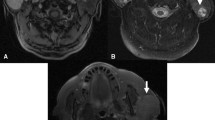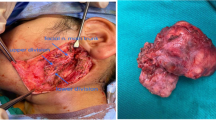Abstract
Although salivary gland surgery for benign diseases is an integral part of clinical routine of head and neck surgeons, there is not many population-based data published on incidence and efficiency of this surgery. Parotidectomy was performed in 180 patients and submandibulectomy in 97 patients for benign diseases in eight otorhinolaryngology and two maxillofacial surgery departments in Thuringia, Germany, in 2005. All patients were analysed regarding patients’ characteristics, therapy, complications and further course of disease. Predominant indications were epithelial tumours for parotidectomy (79 %) and sialolithiasis for submandibulectomy (50 %). The most frequent tumour types were pleomorphic adenoma (46 %) and Warthin tumours (29 %). Pleomorphic adenoma was significantly more frequent in female patients and Warthin tumours in male patients and smokers. The incidence of parotidectomy, i.e. the surgical rate, was 7.8/100,000 habitants and of submandibulectomy 4.1/100,000 habitants. One hundred and seventy-eight tumours including 154 epithelial tumours resulted in an incidence of 7.6/100,000 habitants for all treated tumours and of 6.6/100,000 for epithelial tumours, respectively. The majority of parotid cases were treated by lateral parotidectomy (79 %). Relevant complications were observed in 22 % of patients. After parotidectomy and submandibulectomy a postoperative facial palsy was observed in 28 and 2 % of cases, respectively. Only 1 % was permanent. During a mean follow-up time of 9.6 months, 3 % of parotidectomy patients developed a Frey’s syndrome needing treatment and 0.8 % developed a tumour recurrence. This population-based analysis shows that salivary gland surgery is performed in higher incidence than expected, effectively and with low-risk in daily routine of head and neck surgeons.

Similar content being viewed by others
References
Grant GA, Bradley PT (2011) Epidemiology of benign salivary gland neoplasms. In: Bradley PJ, Guntinas-Lichius O (eds) Salivary Gland Disorders and Diseases: Diagnosis and Management. Thieme, Stuttgart
Przewozny T, Stankiewicz C (2004) Neoplasms of the parotid gland in northern Poland, 1991–2000: an epidemiologic study. Eur Arch Otorhinolaryngol 261(7):369–375
Eveson JW, Cawson RA (1985) Salivary gland tumours. A review of 2410 cases with particular reference to histological types, site, age and sex distribution. J Pathol 146(1):51–58
Spiro RH (1986) Salivary neoplasms: overview of a 35-year experience with 2,807 patients. Head Neck Surg 8(3):177–184
Guntinas-Lichius O, Klussmann JP, Wittekindt C, Stennert E (2006) Parotidectomy for benign parotid disease at a university teaching hospital: outcome of 963 operations. Laryngoscope 116(4):534–540
Thackray AC (1968) Salivary gland tumours. Proc R Soc Med 61(11):1089–1090
Eneroth CM (1971) Salivary gland tumors in the parotid gland, submandibular gland, and the palate region. Cancer 27(6):1415–1418
Guntinas-Lichius O, Wendt T, Buentzel J, Esser D, Lochner P, Mueller A, Schultze-Mosgau S, Altendorf-Hofmann A (2009) Head and neck cancer in Germany: a site-specific analysis of survival of the Thuringian cancer registration database. J Cancer Res Clin Oncol 136(1):55–63
Seyring C, Bitter T, Boger D, Buntzel J, Esser D, Hoffmann K, Jecker P, Muller A, Radtke G, Guntinas-Lichius O (2012) Health services research on paranasal sinus surgery in thuringia: epidemiologic key data and outcome. Laryngorhinootol 91(7):434–439
OPS (2005) Systematisches Verzeichnis (2005). Deutscher Ärzteverlag, Köln
Barnes L, Eveson JW, Reichart P, Sidransky D (2005) Pathology and Genetics of Head and Neck Tumours. IARC Press, Lyon
Pinkston JA, Cole P (1999) Incidence rates of salivary gland tumors: results from a population-based study. Otolaryngol Head Neck Surg 120(6):834–840
Mortensen KS, Hjortlund J, Bjorndal K, Krogdal A, Godballe C (2008) Salivary gland tumors in the County of Funen, 1984–2003. Ugeskr Laeger 170(7):545–548
Bradley PJ (2012) General epidemiology of salivary gland tumours. In: McGurk MC, Renehan A (eds) Controversies in the management of salivary gland diseases. Oxford University Press, Oxford
Bradley PJ, Guntinas-Lichius O (2011) Salivary Gland Disorders and Diseases: Diagnosis and Management. Thieme, Stuttgart
Wittekindt C, Burmeister HP, Guntinas-Lichius O (2009) Diagnostic and therapy of salivary gland diseases: relevant aspects for the pathologist from the clinical perspective. Pathologe 30(6):424–431
Iro H, Zenk J, Koch M (2010) Modern concepts for the diagnosis and therapy of sialolithiasis. HNO 58(3):211–217
Becker M (2011) Evaluation of salivary glands-imaging. In: Bradley PJ, Guntinas-Lichius O (eds) Salivary Gland Disorders and Diseases: Diagnosis and Management. Thieme, Stuttgart
Wittekindt C (2011) Patient history and clinical examination. In: Bradley PJ, Guntinas-Lichius O (eds) Salivary Gland Diseases: Diagnosis and Management. Thieme, Stuttgart
Tandon S, Shahab R, Benton JI, Ghosh SK, Sheard J, Jones TM (2008) Fine-needle aspiration cytology in a regional head and neck cancer center: comparison with a systematic review and meta-analysis. Head Neck 30(9):1246–1252
Albergotti WG, Nguyen SA, Zenk J, Gillespie MB (2012) Extracapsular dissection for benign parotid tumors: A meta-analysis. Laryngoscope [Epub ahead of print]; doi:10.1002/lary.23396
Guntinas-Lichius O (2011) Morbidity of treatment. In: Bradley PJ, Guntinas-Lichius O (eds) Salivary Gland Disorders and Diseases: Diagnosis and Management. Thieme, Stuttgart
Preuss SF, Klussmann JP, Wittekindt C, Drebber U, Beutner D, Guntinas-Lichius O (2007) Submandibular gland excision: 15 years of experience. J Oral Maxillofacial Surg 65(5):953–957
Conflict of interest
The authors indicate that they have no a financial relationship with any organization or company mentioned in the manuscript. The research was not sponsored by a third party.
Author information
Authors and Affiliations
Corresponding author
Rights and permissions
About this article
Cite this article
Moeller, K., Esser, D., Boeger, D. et al. Parotidectomy and submandibulectomy for benign diseases in Thuringia, Germany: a population-based study on epidemiology and outcome. Eur Arch Otorhinolaryngol 270, 1149–1155 (2013). https://doi.org/10.1007/s00405-012-2225-y
Received:
Accepted:
Published:
Issue Date:
DOI: https://doi.org/10.1007/s00405-012-2225-y




